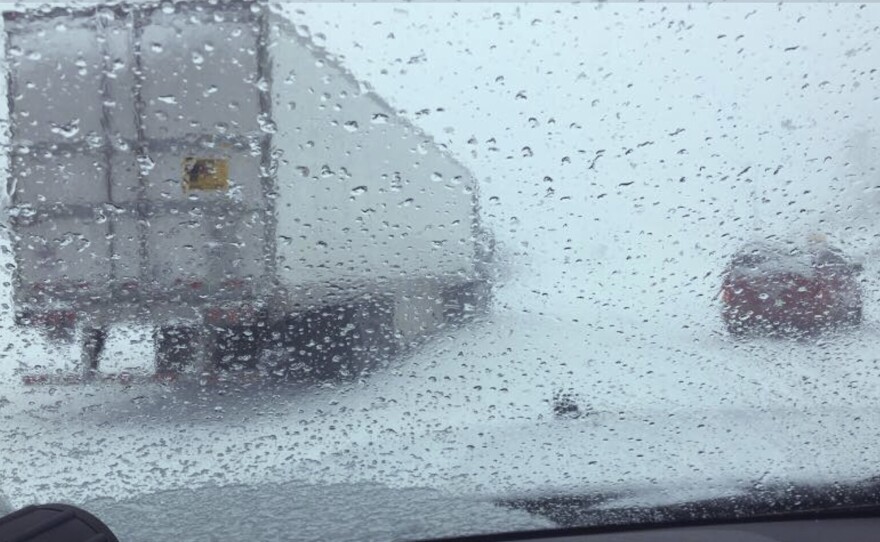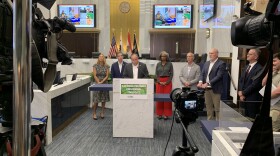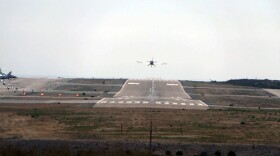Updated at 1:30 p.m. ET:
A storm that Southern California had feared would trigger more mudslides in wildfire-stricken areas appears to be passing through the area without incident, the Associated Press reports, before it's expected to drop several feet of snow on the Sierra Nevadas. But a major nor'easter continues to pummel parts of the U.S. East Coast.
The National Weather Service warned that the nor'easter could deliver up to a foot of snow in parts of New York, Pennsylvania and northern New England, with hurricane-strength winds possible near Cape Cod, Massachusetts. Boston is anticipating flooding downtown as the tide peaks around midday, reports Tina Martin of WGBH.
Lighter snowfall — from 2 to 5 inches — was expected from Boston through Rhode Island.
"This could be one of those storms that goes into the record books," said Kim Buttrick, a National Weather Service meteorologist in Taunton, Mass. "This is a very dangerous storm."
By early afternoon, 700,000 customers in Eastern states had lost electricity, the Associated Press reports, with the highest numbers in Virginia, Pennsylvania and New York.
Hundreds of flights were canceled across the region, with high winds increasing turbulence. One pilot who landed at Dulles Airport in Virginia Friday morning reported widespread nausea on board.
Massachusetts Gov. Charlie Baker activated 200 National Guard members to help with the storm. He said the state was "expecting to see more severe flooding issues here than we did in the Jan. 4 storm," when a previous nor'easter hammered the region with snow and rain.
"It's not snow, it's rain, but the rain and the wind, at the rates that we're going to deal with it, mixed with potentially snow in the afternoon, could create some really challenging issues for all of us," Baker said.
The AP reports that "In Duxbury, south of Boston, officials urged people to evacuate as soon as possible, and the fire department was preparing to use a high water rescue vehicle for the first time to help any residents who wind up stuck in homes during high floodwaters."
The Coast Guard advised "vigilance and extreme caution" for mariners and offshore winds near the Massachusetts coast were forecast up to 75 knots Friday night, with seas "building to 29 to 44 feet."
In New Jersey, worried about damage to the beaches south of Atlantic City, the AP reports, and authorities advised coastal residents across the affected region to be prepared to evacuate ahead of Friday morning's high tide.
Rhode Island was also under flood and wind watches.
Meanwhile, on the other side of the country in Southern California, the worst of a major storm passed without triggering new debris flows on slopes denuded by summer wildfires.
Up to 30,000 people were under evacuation orders in foothills of Santa Barbara County, with sheriff's deputies going door-to-door ordering people to leave, but flash flood warnings for the area were lifted around 9:45 a.m. ET, The Associated Press reports.
" 'Things are going very well,' Suzanne Grimmesey, a spokeswoman for Santa Barbara County, said shortly before dawn. 'The worst of the storm has passed over.' "
It's a favorable outcome from "the biggest storm of the season," as Jim Mathews, a meteorologist with the National Weather Service in Sacramento, described it to The Los Angeles Times.
The Times writes:
"Forecasters are predicting up to 7 feet of snow in the Sierra Nevada, with up to 10 feet possible in the highest elevations in the mountain range. But to the south, predictions of heavy rain Friday brought fears of more flooding in area hit by last December's firestorms, particularly in Montecito, where mudslides in January killed more than 20 people."
Parts of the Sierra Nevada remain under a blizzard warning, with gusts up to 125 mph expected, according to the NWS.
Christopher Dean Hopkins contributed to this story.
Copyright 2018 NPR. To see more, visit http://www.npr.org/.






